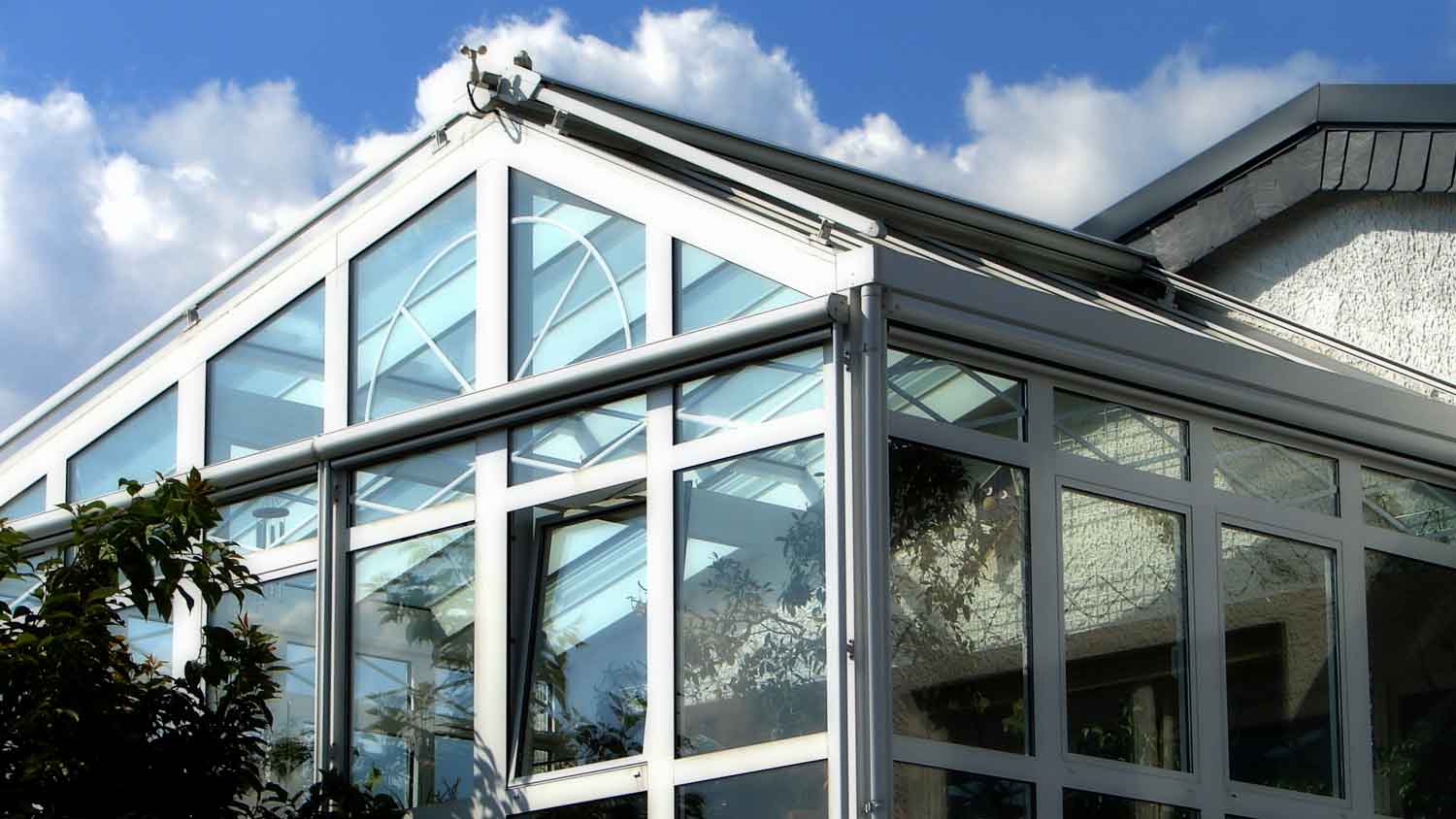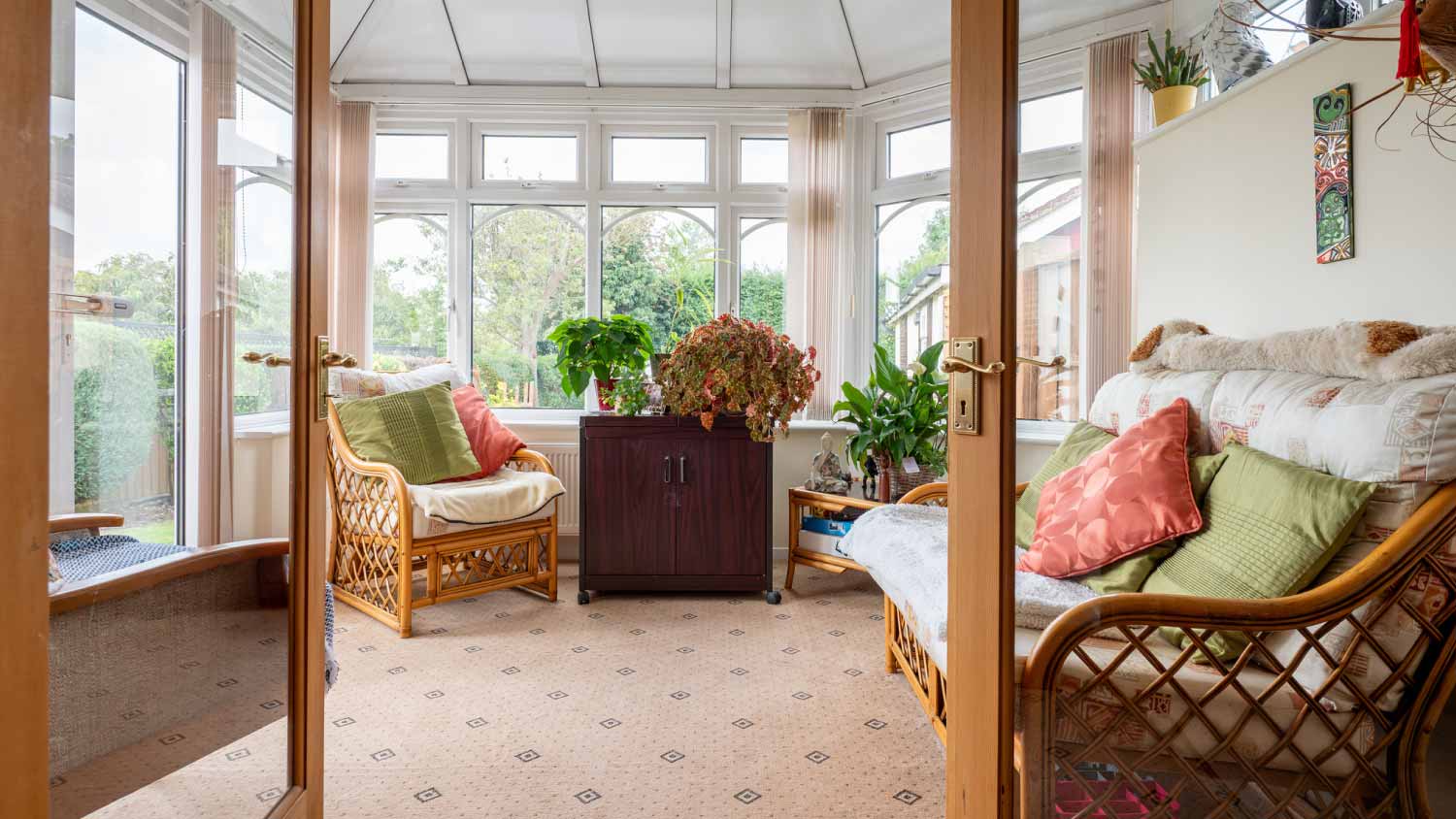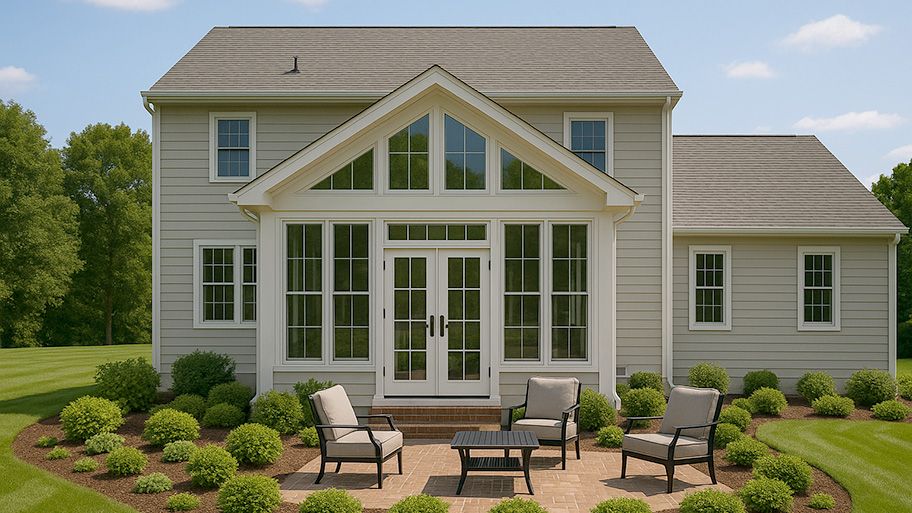
Use our expert guide to figure out how much it costs to install a pool enclosure. Establish your budget, then plan your pool enclosure project.
Soak up the sun and save with prefab


Sunrooms are enclosed spaces with large windows that fill a home with sunlight.
Prefab sunrooms are manufactured in a factory and then assembled on-site.
Prefab sunrooms cost half as much as traditional stick-built sunrooms.
You’ll still need building permits to install a prefab sunroom, so be sure to budget for permit fees.
Maybe the vision of sunbathing while still being in the comfort of an enclosed space has you sold on adding a sunroom to your home. But even once you’ve settled on a sunroom, you still have to decide if you want it built from the ground up or prefabricated and brought to you. Let’s take a look at the pros and cons of prefab sunrooms, what they cost, and how they compare to traditional ones.
Just like a standard sunroom, a prefab sunroom is a room addition to your home that has lots of glass to maximize sunlight and views of the outdoors. The difference is that a traditional sunroom involves a crew building the space from scratch on-site, while a prefab sunroom is manufactured in a factory and then delivered and installed on your home by a pro.
Sunrooms provide a space to enjoy the outdoors without potential annoyances, like bugs, rain, and even sunburn. There are many types of sunrooms that vary in utility. You can go with a simple screened-in porch, upgrade to a three-season room, or go all out with a four-season room that’s heated and cooled to provide year-round comfort and enjoyment.
Despite not being built from the ground up at your home, you can still choose a style of prefab sunroom that meets your needs and personal taste.
Screened-in porch: A screened-in porch has a wood, aluminum, or vinyl frame with open screens making up most of the walls. This provides maximum ventilation but still keeps sunlight and bugs out.
Solarium: A solarium has a wood or metal frame, but most of the walls and the roof are made of glass. This provides more sunlight but minimal privacy.
Three-season room: A three-season sunroom has a roof that matches your home, but the walls are mostly made of windows to allow natural light in. This type doesn’t have heating or cooling.
Four-season room: A four-season sunroom is like a three-season sunroom, but it has wiring and is tied into your HVAC system to make it comfortable year-round. Because of the higher-quality materials used, this style of prefab sunroom typically costs more than a three-season one.

Prefab sunrooms offer some advantages over traditional ones.
Planning a home addition can be stressful when you’re on a budget. Prefab sunrooms can be a great option since they often cost half as much as traditional stick-built sunrooms. For this reason, many homeowners go the prefab route because it offers the best of both worlds—a beautiful sunroom for a budget-friendly price.
If you’re looking for a simple yet stunning sunroom without fancy customization and have an existing structure to attach it to, you could potentially save thousands of dollars going prefab.
If you find yourself counting down the minutes until you’re soaking up the sun in your new sunroom, you’ll be happy to know that the prefab sunroom can usually be assembled in just a few days. Construction off-site also means fewer delays due to bad weather.
There are some drawbacks compared to traditional sunrooms, though.
While there are still many aesthetically pleasing prefab designs to choose from, one common criticism of prefab sunrooms is that they provide fewer design options. You may have to forgo some of your more specific aesthetic preferences if you opt for the prefab.
You can expect 10 to 20 years of life from your prefab sunroom, which is less life than you’d get from a more formal home addition on a slab foundation.
Prefab sunrooms are faster and more affordable to install. Sunroom contractors will install these on concrete piles or even on existing decks, so your yard will be far less disrupted than if you excavated and poured a slab foundation for a stick-built sunroom.
Custom-built sunrooms, of course, give you more flexibility when it comes to design and materials. It’s easier to match your siding, roof, and home design, and you won’t be restricted as much with regard to sizing and shape. Custom-built sunrooms also last for 50 to 100 years or more, so you’ll get much more value out of a custom sunroom.
Choosing which is right for your home depends on many factors. Consider the up-front cost, how much say you want to have in the design, and the ROI you want to see from your home addition. Generally speaking, custom-built sunrooms will see a higher ROI, in large part due to the greater visual appeal and better longevity.
Prefab sunroom kits range from $5,000 to $30,000, depending on size, materials, brand, and more. Your cost will also depend on the foundation you’re choosing for your sunroom. Installing a prefab sunroom on an existing, structurally sound deck will cost toward the lower end, while pouring concrete piles to act as the foundation will push your costs higher.
Traditional sunrooms cost between $20,800 and $72,600. The exact figure will vary based on your home’s location, cost of materials, sunroom size, and how much prep work your pro needs to do to install the home addition.
Once your prefab sunroom is manufactured and brought to you, you might be wondering whether you should hire a local sunroom contractor or finish the installation yourself. This will all depend on your expertise and comfort level.
Some experienced DIYers may be able to assemble a prefabricated sunroom kit for a fraction of what it takes to enlist a pro. However, this still requires a high degree of skill and DIY experience, so it’s best to hire a pro to get the job done properly. Installing a prefab sunroom will still require permits, too, and your building department may require a licensed pro to pull permits for the work. In that case, DIYing may not be legal.
Permits can actually be quite expensive. Talk to your contractors before starting your project to understand how much the required permits will cost you.
From average costs to expert advice, get all the answers you need to get your job done.

Use our expert guide to figure out how much it costs to install a pool enclosure. Establish your budget, then plan your pool enclosure project.

How much does it cost to rescreen your porch or sunroom? Learn about screen materials, average labor costs, and other costs for rescreening your porch.

Love soaking up sun but can’t stand the bugs? Learn how much a Florida room addition costs and what factors influence the price to get the best of both worlds.

Get some inspiration and DIY ideas for turning your screened-in porch into a beautiful and tranquil place to enjoy the outdoors in comfort and style.

A screened porch can keep you comfortable and pest-free all year long. Learn how to screen in a porch in eight simple steps.

Both offer livable space in a home, but there are many differences between the two. Learn the pros and cons to decide between a sunroom and a room addition.